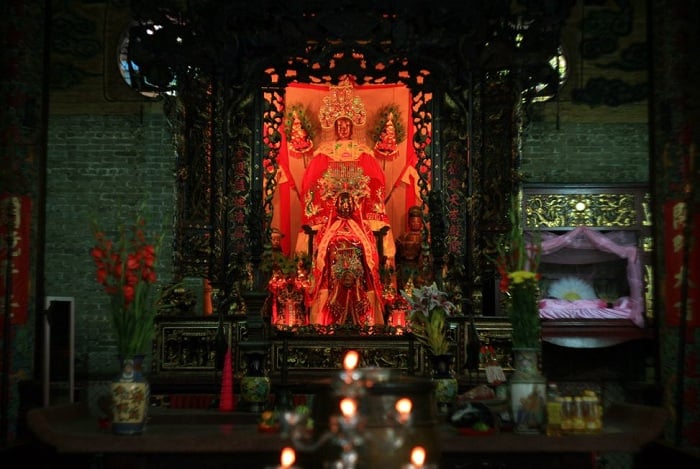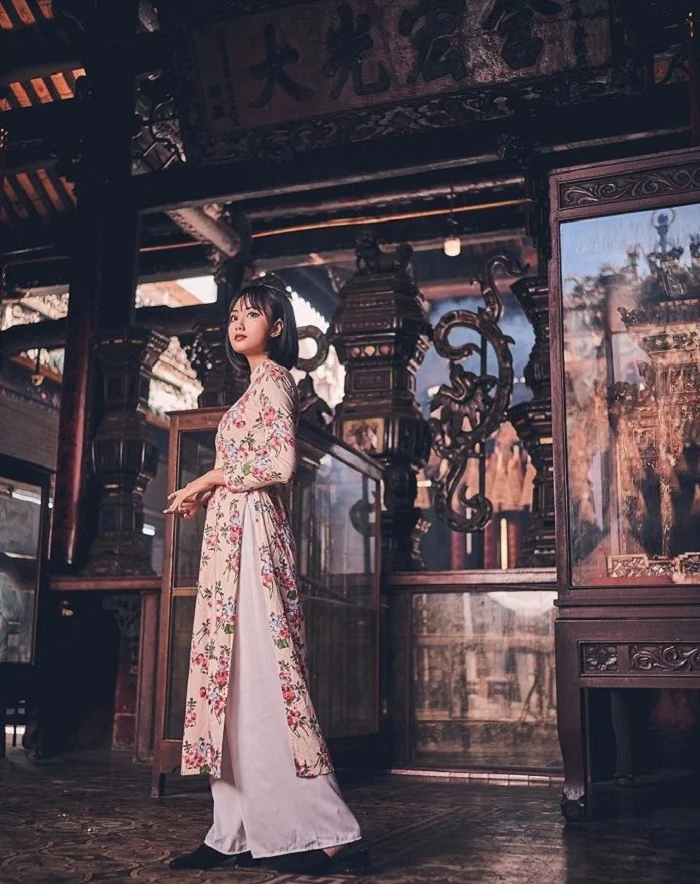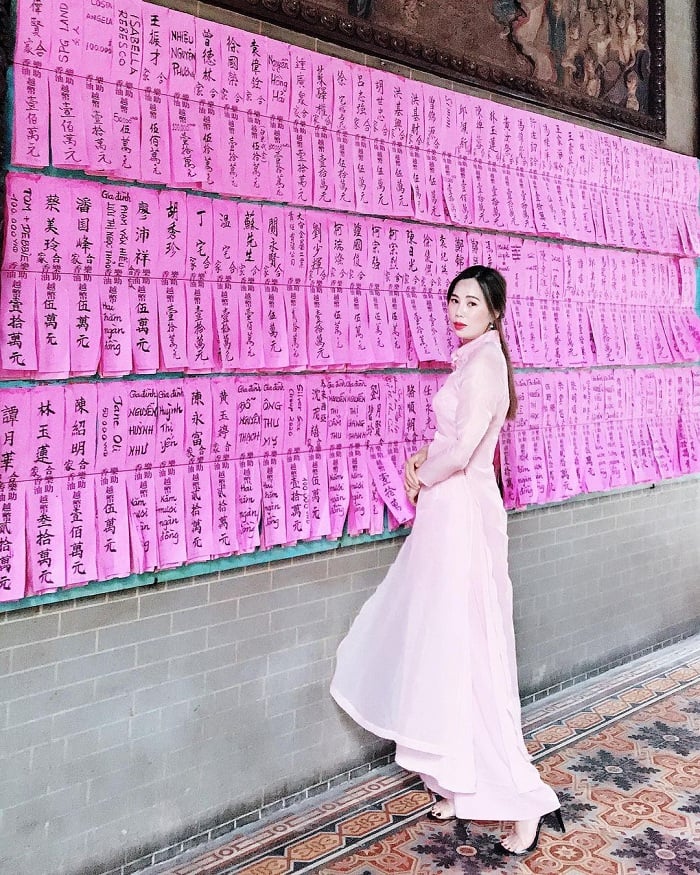Thien Hau Pagoda, located in the heart of District 5, Ho Chi Minh City, is a renowned spiritual tourist destination celebrated for its sacred ambiance and a tranquil space that provides a complete escape from the vibrant daily hustle and bustle. Let’s unravel its most unique and distinctive features through the following article with DanangPrivateCar.com’s.
Thien Hau Pagoda – A Sacred Ancient Temple of the Chinese Community in the Heart of Ho Chi Minh City
- Address: 710 Nguyen Trai Street, Ward 11, District 5, Ho Chi Minh City
- Opening hours: 6:30 AM – 4:30 PM
Thien Hau Pagoda (or the Từ Thành Assembly Hall) is one of the oldest places of worship for the Chinese community in Ho Chi Minh City, playing a significant role in the spiritual life of the local people and holding great spiritual value. Right next to the pagoda is the Từ Thành Assembly Hall of the Cantonese Chinese. The temple dedicated to Thien Hau is renowned for its sacredness, and if you visit during festive occasions or the Lunar New Year, you will witness a bustling scene of people coming and going from morning until evening.

See more articles: Explore 8 most sacred and beautiful temples in Ho Chi Minh City
Directions to the Pagoda
As it is located in the historic and well-known Chinatown of Ho Chi Minh City, finding your way to the pagoda is not too difficult. The simplest instructions for visitors are to proceed straight on Nguyen Thi Minh Khai, Hung Vuong, Hong Bang, and then turn left at Luong Nhu Hoc Street onto Nguyen Trai Street.
Additionally, if you wish to explore quickly and comfortably, you can use our private car service with drivers in Ho Chi Minh City. With our professional drivers and years of experience, we will ensure you have the fastest journey to Thien Hau Pagoda, as well as many other tourist destinations in HCM City.
The History and Legend of Thien Hau Pagoda
Formation of Tue Thanh Assembly Hall
The assembly hall was established by a group of Chinese immigrants from Tuệ Thành (Quangzhou, Guangdong Province) who contributed capital and participated in its construction upon migrating to Vietnam. Due to the prolonged construction and renovation process, there are currently no specific documents indicating the exact year of the assembly hall’s construction. Some opinions suggest that Thien Hau Pagoda as it stands today was built in the year 1760.

Within the assembly hall, significant artifacts such as the grand red bell and the set of Pháp Lam scriptures remain, with inscriptions dating back to the “10th Dao Quang” year, equivalent to the year 1830. Trịnh Hoài Đức’s “Gia Dinh thanh thong chi,” compiled around 1820, makes mention of the Tue Thanh Assembly Hall.
Legend of Thien Hau Pagoda
The story of the first Chinese settlers who ventured from their homeland to establish themselves in Vietnam spans thousands of years of history. They brought not only their material possessions but also the distinct cultural traits of the Northern region, along with prominent beliefs in the worship of deities. Thien Hau Pagoda stands out as a prominent spiritual landmark, dedicated to Thien Hau Thanh Mau (commonly known as Bà Thiên Hậu), whose real name is Lâm Mặc Nương, a person from Mi Châu, Phúc Kiến.
Lâm Mặc Nương, a historical figure from the Song Dynasty in China, was said to be born on the 14th month (contrary to the usual 9 months and 10 days gestation period). As she grew older, her abilities in astronomy became evident as she regularly observed the stars, predicted the weather, and assisted fishermen.
On one occasion, when her father and two brothers were transporting salt to sell in the west, their boat encountered a severe storm. Lâm Mặc Nương, who was asleep at the time, miraculously woke up and rushed to rescue everyone. Using her teeth, she bit into her father’s shirt collar, gripping the two brothers with her hands. Unfortunately, at that moment, her mother woke her up, and as she answered, the waves carried her father away, leaving only the two brothers saved. From that time on, the legend of Lâm Mặc Nương’s abilities spread far and wide, and she became a revered goddess among fishermen, often worshipped during times of peril at sea.
Unique Architectural Features of Thien Hau Pagoda
Thien Hau Pagoda is constructed in a distinctive architectural style typical of the Chinese, comprising four interconnected buildings forming a layout resembling the shape of a “mouth” or the character “quốc” (country). In the center, three rows of buildings create the front, middle, and rear chambers. In the midst of these rows is an open space known as thiên tỉnh (sky well), providing ventilation, ample light, and a means to dissipate smoke.
The buildings are adorned with intricate details of flowers, leaves, mythical creatures, horizontal lacquered boards, couplets, and self-transforming characters, often in red and gold. Additionally, within the premises of Thien Hau Pagoda, there are continuous relief sculptures depicting the “four mythical creatures.”
Front Chamber of Thien Hau Pagoda
In the front chamber of Thien Hau Pagoda, the altar of Phúc Đức Chánh Thần is placed on the right side, while the altar of Môn Quan Vương Tả is arranged on the left. Here, visitors can also admire stone steles documenting legends about Thien Hau Thanh Mau and paintings portraying her divine appearances on the waves.

Middle Chamber of Thien Hau Pagoda
The middle chamber of Thien Hau Pagoda features the finely carved “Phát Lan” set, consisting of five pieces. On either side are depictions of a dragon-headed boat touching a human-shaped figure and a palanquin adorned with gold-coated bronze decorations. These items are used to process rituals during Thien Hau’s commemoration day.
Rear Chamber (Main Chamber) of Thien Hau Pagoda
Moving to the main chamber, you arrive at the Thien Hau Palace, consisting of three sections:
- The central section honors Thien Hau Thanh Mau, carved from an ancient wood block, standing 1 meter tall.
- Kim Hoa Nương Nương is worshipped on the right, and Long Mẫu Nương Nương is worshipped on the left.
- The two side sections house statues of Quan Thánh, Địa Tạng, and Thần Tài.
All the statues are adorned with luxurious embroidered garments.

Precious Artifacts Preserved at Thien Hau Pagoda
Especially noteworthy is the collection of precious artifacts at Thien Hau Pagoda. Approximately 400 antiquities are currently preserved here, including relief sculptures featuring the “four mythical creatures” – Dragon, Unicorn, Tortoise, and Phoenix. The roof, eaves, and walls are adorned with ceramic statues and reliefs inspired by Chinese models.

Moreover, the pagoda houses numerous precious woods, aloeswood, and incense. Visitors will be deeply impressed by 10 horizontal lacquered boards, 9 stone steles, 7 ceramic statues of deities, 6 stone statues, 2 small bells, 23 couplets, 41 relief paintings, all meticulously crafted with intricate details.
Characteristic Features Not to Miss at Thien Hau Pagoda
Precious Treasures Preserved at Thien Hau Pagoda
Visiting Thien Hau Pagoda not only allows us to pay homage but also provides an opportunity to admire rare and precious artifacts. Approximately 400 antique items are showcased here, including relief paintings depicting dragons, unicorns, tortoises, and phoenixes. On the roof, walls, and eaves, there are ceramic statues and reliefs inspired by Chinese traditions.
In addition, the pagoda houses various precious woods, aloeswood, and incense. Particularly noteworthy are 10 horizontal lacquered boards, 9 stone steles, 2 small bells, and 7 ceramic statues of deities—all meticulously crafted with intricate details.
Instagrammable Check-In Spots
At Thien Hau Pagoda, you will capture impressive Instagram-worthy photos amidst a space with nostalgic architectural elements. This is why bringing a camera is essential to capture the beauty of this place. The majestic appearance and the time-worn ambiance are fully reproduced in the photos taken by young visitors. Each corner of the pagoda has its own distinct charm. Images of sturdy green fences, pink wish boards, and ancient brick walls are among the top favorite check-in points for tourists.

Taking photos at the pink wish board at Thien Hau Pagoda
Spiritual Experience and Prayer Location
Most visitors to Thien Hau Pagoda come to pray for blessings for themselves and their families. DanangPrivateCar.com’s suggests that you can read the prayers dedicated to Bà or write down your wishes on paper and hang them with the burning incense, hoping that your wishes will come true. Another popular practice among young enthusiasts is seeking divination, hoping to foresee future challenges and be more proactive in facing uncertainties.
The Largest “Via Ba” Festival in Ho Chi Minh City
You can visit Thien Hau Pagoda at any time throughout the year. However, it is livelier if you explore it from the 22nd to the 24th of the third lunar month. This marks the annual “Via Ba” festival, attracting a large number of Chinese and Vietnamese people for worship.

On this day, the statue of Thien Mau Thanh Mau is placed on a palanquin and paraded around the pagoda. Accompanying this are lively activities such as lion dances, dragon dances, and other artistic performances performed by ethnic music groups, adding to the festive atmosphere.
It can be said that Thien Hau Pagoda is one of the oldest Chinese temples in the city, renowned for its sacredness and possession of numerous valuable ancient artifacts. Include this attraction in your travel guide for a meaningful journey of exploring Ho Chi Minh City.


